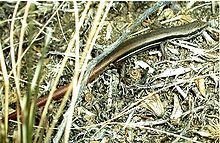Subphylum Vertebrata | Phylum Chordata Class Reptilia Suborder Sauria Rank Species | |
 | ||
Similar Morethia, Common dwarf skink, Egernia striolata, Menetia, Ctenotus | ||
Morethia boulengeri is a species of scincid lizard endemic to Australia. Common names for this species include south-eastern Morethia skink, Boulenger's snake-eyed skink, Boulenger's Morethia, and Boulenger's skink. The specific name, boulengeri, as well as two of the common names for this skink, are in honor of George Albert Boulenger, a Belgian-born British herpetologist who described a wide range of reptile, amphibian and fish species.
Contents
Description
The markings and coloration of these skinks can vary significantly between individuals. In general, M. boulengeri are grey or brown in colour with coloured flecks in a longitudinal pattern along the dorsal side of the lizard, while the ventral side is largely white. A thin white stripe also runs longitudinally from the mouth to the groin region on both lateral sides. Above the white line is a thicker black stripe that borders the white stripes. Juvenile lizards also have a distinctive red-orange tinge on the ventral side of the tail, which is a distinguishing feature of the Morethia genera. The Boulengeri’s skink can grow to 10 cm in length; however, on average they reach only 8 cm nose to tail, or 45-50mm snout to vent. This species of skink also exhibits square-shaped supraciliary scales above the eye region.
Ecology
This species is endemic to Australia and can be found across the majority of the country. M. Boulengeri lives in every state and territory except Tasmania. They are generalist species that have the ability to inhabit a wide range of environments in semi-arid and arid zones. They survive in the leaf litter and dead fallen vegetation in dry sclerophyll forests, mallee, desert, scrublands, woodlands and low shrublands ecosystems. They are found in high numbers in the Murray catchment area, in southern New South Wales. Sometimes the densities of the M. boulenger are as high as several hundred individuals in one hectare of land.
Diet
The M. boulenger are insectivore species, like the majority of skinks, which means the diets of these species consist exclusively of insects. The skinks eat predominately arthropod species and snails, with moths making up a large portion of their diet. While spiders, beetles, ants, cockroaches and other bugs are also a part of the skinks diet. All of these prey species are abundant within Australia and in the leaf litter habitat the M. boulenger also occupy.
Reproduction
M. boulenger mate in the warmer months in spring and summer. During this time the throat of male skinks turns vibrant orange in correspondence with testicle size, indicating to the females that they are fertile and available for mating. This species of skink is oviparous which is a method of reproduction where the females lay eggs. The female M. boulenger generally reach sexual maturity and begin breeding within the first year of life. On average, 3 eggs are laid per clutch and produce approximately 3 clutches per year. The clutch is incubated for approximately 60 days before the eggs hatch. During this time the rate of oxygen consumption dramatically increases.
